Enhanced Mechanical Properties and Isotropy of Mg-2Al-0.8Sn Alloy through Ca Addition
Abstract
:1. Introduction
2. Experimental Procedure
3. Results and Discussion
3.1. Microstructural Characteristics
3.2. Mechanical Properties
4. Conclusions
- (1)
- With the addition of Ca in Mg-2.0Al-0.8Sn alloy from 0.0 wt.% to 0.5 wt.%, the strength, ductility and isotropy of the alloys increase simultaneously. In addition, the ATX2105 alloy shows the best tensile properties with a YS of ∼226.0 MPa, a UTS of ∼282.4 MPa and an EL of ∼20.2% along RD at room temperature.
- (2)
- The second phases of the Ca-modified alloys are CaMgSn, (Mg, Al)2Ca phase and tiny Mg2Ca phase. However, when the Ca content is only 0.3 wt.%, there is only a small amount of (Mg, Al)2Ca and Mg2Ca. The AT21 alloy basically has no second phase.
- (3)
- The enhancement of ductility and anisotropy via (0.0–0.5 wt.%) Ca addition is mainly attributed to the texture modification, which promotes the basal slip and decreases the differences between activated slips for different directions.
- (4)
- The increase in YS under the addition of Ca originates from the synergetic effect of finer grain size, more tiny precipitates and residual dislocation density.
Author Contributions
Funding
Institutional Review Board Statement
Informed Consent Statement
Data Availability Statement
Conflicts of Interest
References
- Barrett, C.D.; Imandoust, A.; Oppedal, A.L.; Inal, K.; Tschopp, M.A.; El Kadiri, H. Effect of grain boundaries on texture formation during dynamic recrystallization of magnesium alloys. Acta Mater. 2017, 128, 270–283. [Google Scholar] [CrossRef]
- Beausir, B.; Biswas, S.; Kim, D.I.; Tóth, L.S.; Suwas, S. Analysis of microstructure and texture evolution in pure magnesium during symmetric and asymmetric rolling. Acta Mater. 2009, 57, 5061–5077. [Google Scholar] [CrossRef]
- Gong, X.; Kang, S.B.; Cho, J.H.; Li, S. Effect of annealing on microstructure and mechanical properties of ZK60 magnesium alloy sheets processed by twin-roll cast and differential speed rolling. Mater. Charact. 2014, 97, 183–188. [Google Scholar] [CrossRef]
- Xu, H.; Guo, Z.P.; Zhang, P.Y.; Zhou, Y.; Ma, P.K. Influence of Texture on the Mechanical Properties of a Mg-6Al-1Zn-0.9Sn Alloy Processed by ECAP. Materials 2021, 14, 2664. [Google Scholar] [CrossRef]
- Liu, X.; Qiao, X.; Li, Z.; Zheng, M. High strength and excellent ductility of dilute Mg-0.68Al-0.32Ca-0.50Mn (wt%) extrusion alloy obtained by T6 treatment. Mater. Charact. 2020, 162. [Google Scholar] [CrossRef]
- Wang, H.-Y.; Zhang, N.; Wang, C.; Jiang, Q.-C. First-principles study of the generalized stacking fault energy in Mg–3Al–3Sn alloy. Scr. Mater. 2011, 65, 723–726. [Google Scholar] [CrossRef]
- Kabir, A.S.H.; Sanjari, M.; Su, J.; Jung, I.-H.; Yue, S. Effect of strain-induced precipitation on dynamic recrystallization in Mg–Al–Sn alloys. Mater. Sci. Eng. A 2014, 616, 252–259. [Google Scholar] [CrossRef]
- She, J.; Pan, F.; Zhang, J.; Tang, A.; Luo, S.; Yu, Z.; Song, K.; Rashad, M. Microstructure and mechanical properties of Mg–Al–Sn extruded alloys. J. Alloys Compd. 2016, 657, 893–905. [Google Scholar] [CrossRef]
- Zhang, A.; Kang, R.; Wu, L.; Pan, H.; Xie, H.; Huang, Q.; Liu, Y.; Ai, Z.; Ma, L.; Ren, Y.; et al. A new rare-earth-free Mg-Sn-Ca-Mn wrought alloy with ultra-high strength and good ductility. Mater. Sci. Eng. A 2019, 754, 269–274. [Google Scholar] [CrossRef]
- Zhou, M.; Huang, X.; Morisada, Y.; Fujii, H.; Chino, Y. Effects of Ca and Sr additions on microstructure, mechanical properties, and ignition temperature of hot-rolled Mg–Zn alloy. Mater. Sci. Eng. A 2020, 769. [Google Scholar] [CrossRef]
- Li, Z.T.; Zhang, X.D.; Zheng, M.Y.; Qiao, X.G.; Wu, K.; Xu, C.; Kamado, S. Effect of Ca/Al ratio on microstructure and mechanical properties of Mg-Al-Ca-Mn alloys. Mater. Sci. Eng. A 2017, 682, 423–432. [Google Scholar] [CrossRef]
- Qudong, W.; Wenzhou, C.; Xiaoqin, Z.; Yizhen, L.; Wenjiang, D.; Yanping, Z.; Xiaoping, X.; Mabuchi, M. Effects of Ca addition on the microstructure and mechanical properties of AZ91magnesium alloy. J. Mater. Sci. 2001, 36, 3035–3040. [Google Scholar] [CrossRef]
- Pan, H.; Qin, G.; Huang, Y.; Ren, Y.; Sha, X.; Han, X.; Liu, Z.-Q.; Li, C.; Wu, X.; Chen, H.; et al. Development of low-alloyed and rare-earth-free magnesium alloys having ultra-high strength. Acta Mater. 2018, 149, 350–363. [Google Scholar] [CrossRef] [Green Version]
- Zhang, B.; Wang, Y.; Geng, L.; Lu, C. Effects of calcium on texture and mechanical properties of hot-extruded Mg–Zn–Ca alloys. Mater. Sci. Eng. A 2012, 539, 56–60. [Google Scholar] [CrossRef]
- Zareian, Z.; Emamy, M.; Malekan, M.; Mirzadeh, H.; Kim, W.J.; Bahmani, A. Tailoring the mechanical properties of Mg–Zn magnesium alloy by calcium addition and hot extrusion process. Mater. Sci. Eng. A 2020, 774, 138929. [Google Scholar] [CrossRef]
- Zhong, L.; Wang, Y.; Dou, Y. On the improved tensile strength and ductility of Mg--Sn--Zn--Mn alloy processed by aging prior to extrusion. J. Magn. Alloys 2019, 7, 637–647. [Google Scholar] [CrossRef]
- Robson, J.D.; Henry, D.T.; Davis, B. Particle effects on recrystallization in magnesium–manganese alloys: Particle-stimulated nucleation. Acta Mater. 2009, 57, 2739–2747. [Google Scholar] [CrossRef]
- Lotfpour, M.; Bahmani, A.; Mirzadeh, H.; Emamy, M.; Malekan, M.; Kim, W.J.; Taghizadeh, M.; Afsharnaderi, A. Effect of microalloying by Ca on the microstructure and mechanical properties of as-cast and wrought Mg–Mg2Si composites. Mater. Sci. Eng. A 2021, 820, 141574. [Google Scholar] [CrossRef]
- Chai, Y.; Jiang, B.; Song, J.; Wang, Q.; Gao, H.; Liu, B.; Huang, G.; Zhang, D.; Pan, F. Improvement of mechanical properties and reduction of yield asymmetry of extruded Mg-Sn-Zn alloy through Ca addition. J. Alloys Compd. 2019, 782, 1076–1086. [Google Scholar] [CrossRef]
- Xiong, J.; Chen, Z.; Yi, L.; Hu, S.; Chen, T.; Liu, C. Microstructure and mechanical properties of annealed Mg–0.6 wt%Zr sheets by unidirectional and cross rolling. Mater. Sci. Eng. A 2014, 590, 60–65. [Google Scholar] [CrossRef]
- Wu, J.; Jin, L.; Dong, J.; Wang, F.; Dong, S. The texture and its optimization in magnesium alloy. J. Mater. Sci. Technol. 2020, 42, 175–189. [Google Scholar] [CrossRef]
- Ma, C.-Y.; Xia, N.; Wang, C.; Li, M.-X.; Hua, Z.-M.; Ren, M.-W.; Wang, H.-Y. A novel Mg-5Al-2Zn-2Sn alloy with high strength-ductility synergy fabricated via simple hot rolling and annealing treatment. J. Alloys Compd. 2021, 869. [Google Scholar] [CrossRef]
- Zhang, S.Y.; Wang, C.; Zhao, L.Q.; Ma, P.K.; Song, J.W.; Xu, J.; Cheng, X.M.; Wang, H.Y. Superplastic Deformation Behavior of Rolled Mg-8Al-2Sn and Mg-8Al-1Sn-1Zn Alloys at High Temperatures. Materials 2020, 13, 1074. [Google Scholar] [CrossRef] [Green Version]
- Kim, W.J.; Jeong, H.G.; Jeong, H.T. Achieving high strength and high ductility in magnesium alloys using severe plastic deformation combined with low-temperature aging. Scr. Mater. 2009, 61, 1040–1043. [Google Scholar] [CrossRef]
- Wang, P.-Y.; Wang, B.-Y.; Wang, C.; Wang, J.-G.; Ma, C.-Y.; Li, J.-S.; Zha, M.; Wang, H.-Y. Design of multicomponent Mg–Al–Zn–Sn–Bi alloys with refined microstructure and enhanced tensile properties. Mater. Sci. Eng. A 2020, 791, 139696. [Google Scholar] [CrossRef]
- Nie, J.F. Effects of precipitate shape and orientation on dispersion strengthening in magnesium alloys. Scr. Mater. 2003, 48, 1009–1015. [Google Scholar] [CrossRef]
- Pan, H.; Kang, R.; Li, J.; Xie, H.; Zeng, Z.; Huang, Q.; Yang, C.; Ren, Y.; Qin, G. Mechanistic investigation of a low-alloy Mg–Ca-based extrusion alloy with high strength–ductility synergy. Acta Mater. 2020, 186, 278–290. [Google Scholar] [CrossRef]
- Li, Z.; Miao, Y.; Liu, F.; Ma, P.; Wang, H. Enhanced precipitation strengthening of Mg-Al-Sn-Ca alloy by multidirectional rolling. Materialia 2021, 19, 101185. [Google Scholar] [CrossRef]
- Wang, P.-Y.; Wang, J.-G.; Jia, H.-L.; Wang, C.; Li, J.-S.; Hu, Z.-T.; Zha, M.; Wang, H.-Y. Development of high strength and formability Mg-6Zn-0.2Ca alloy via multi-pass warm rolling and aging treatment. Mater. Sci. Eng. A 2021, 819, 141452. [Google Scholar] [CrossRef]
- Sun, W.T.; Qiao, X.G.; Zheng, M.Y.; Xu, C.; Kamado, S.; Zhao, X.J.; Chen, H.W.; Gao, N.; Starink, M.J. Altered ageing behaviour of a nanostructured Mg-8.2Gd-3.8Y-1.0Zn-0.4Zr alloy processed by high pressure torsion. Acta Mater. 2018, 151, 260–270. [Google Scholar] [CrossRef] [Green Version]
- Gao, L.; Chen, R.S.; Han, E.H. Effects of rare-earth elements Gd and Y on the solid solution strengthening of Mg alloys. J. Alloys Compd. 2009, 481, 379–384. [Google Scholar] [CrossRef]
- Ma, X.; Huang, C.; Moering, J.; Ruppert, M.; Höppel, H.W.; Göken, M.; Narayan, J.; Zhu, Y. Mechanical properties of copper/bronze laminates: Role of interfaces. Acta Mater. 2016, 116, 43–52. [Google Scholar] [CrossRef] [Green Version]
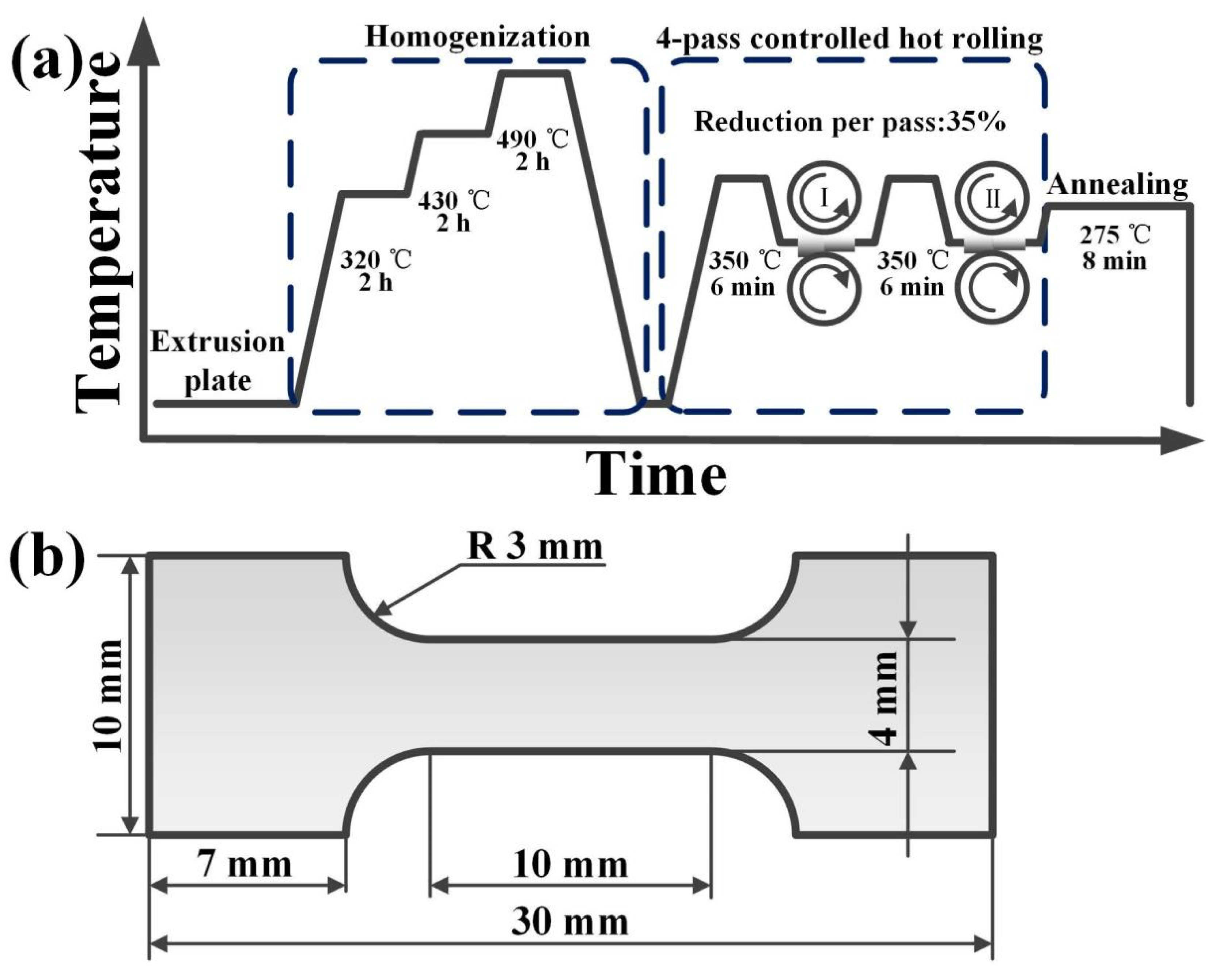
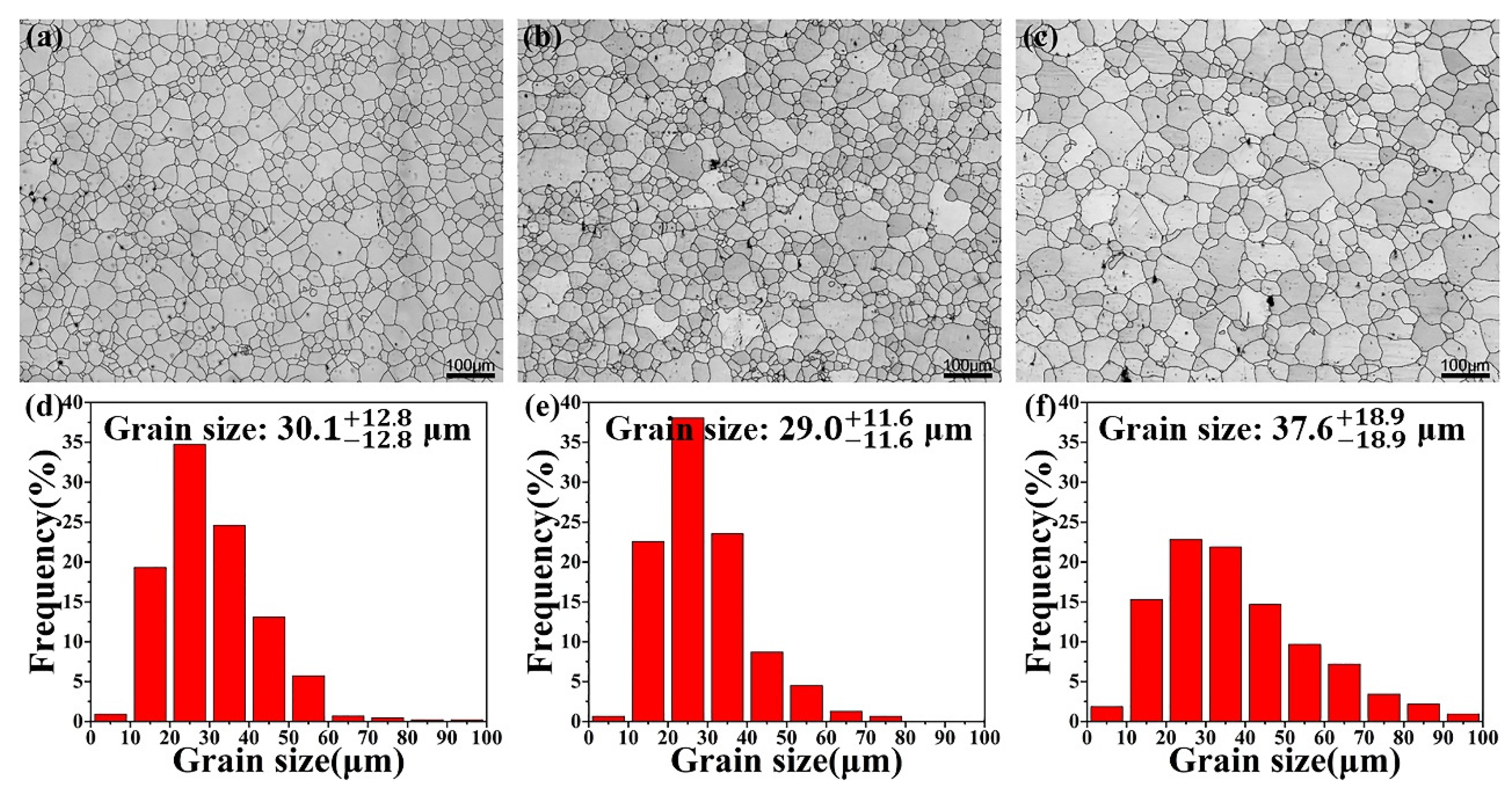


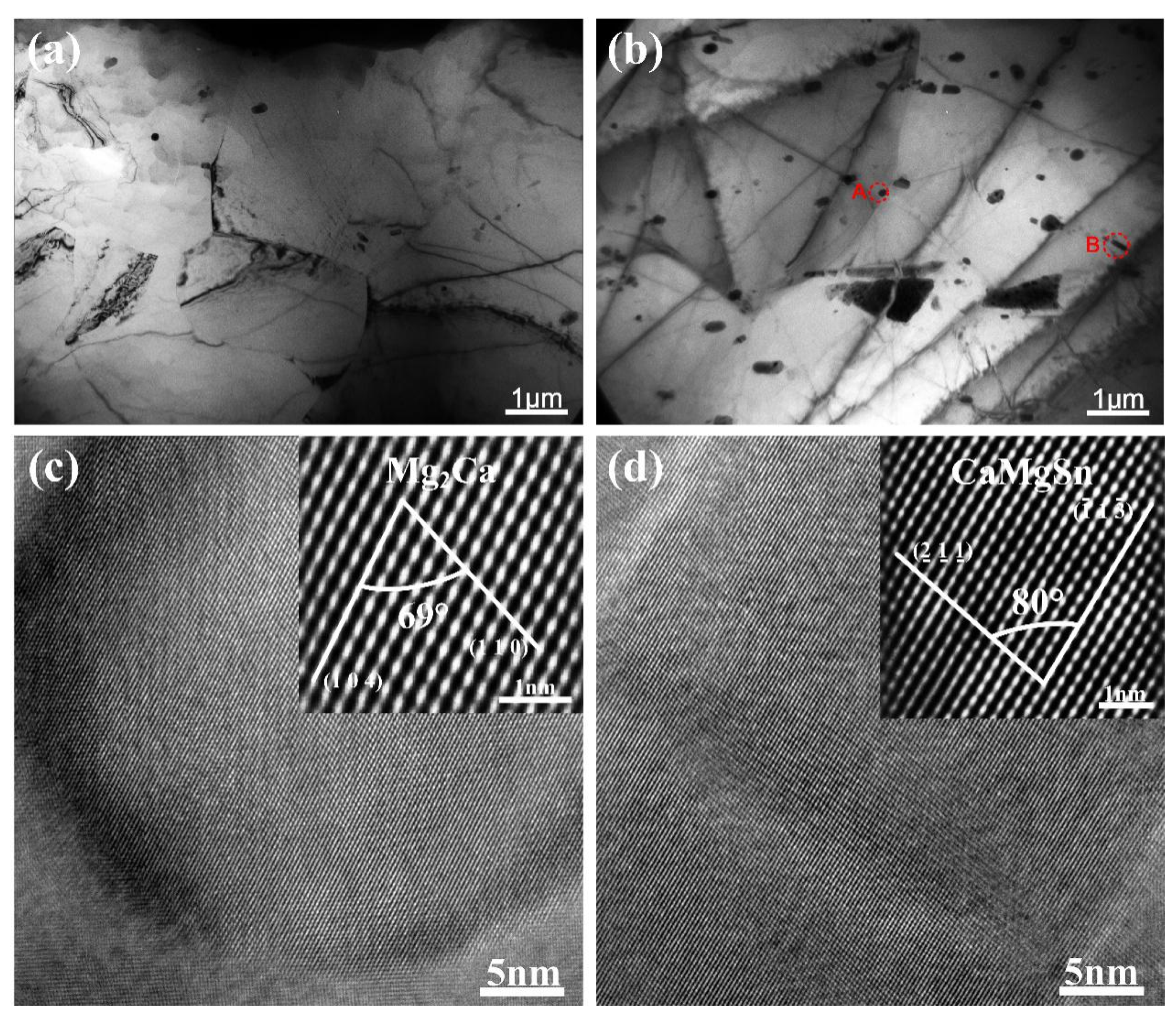

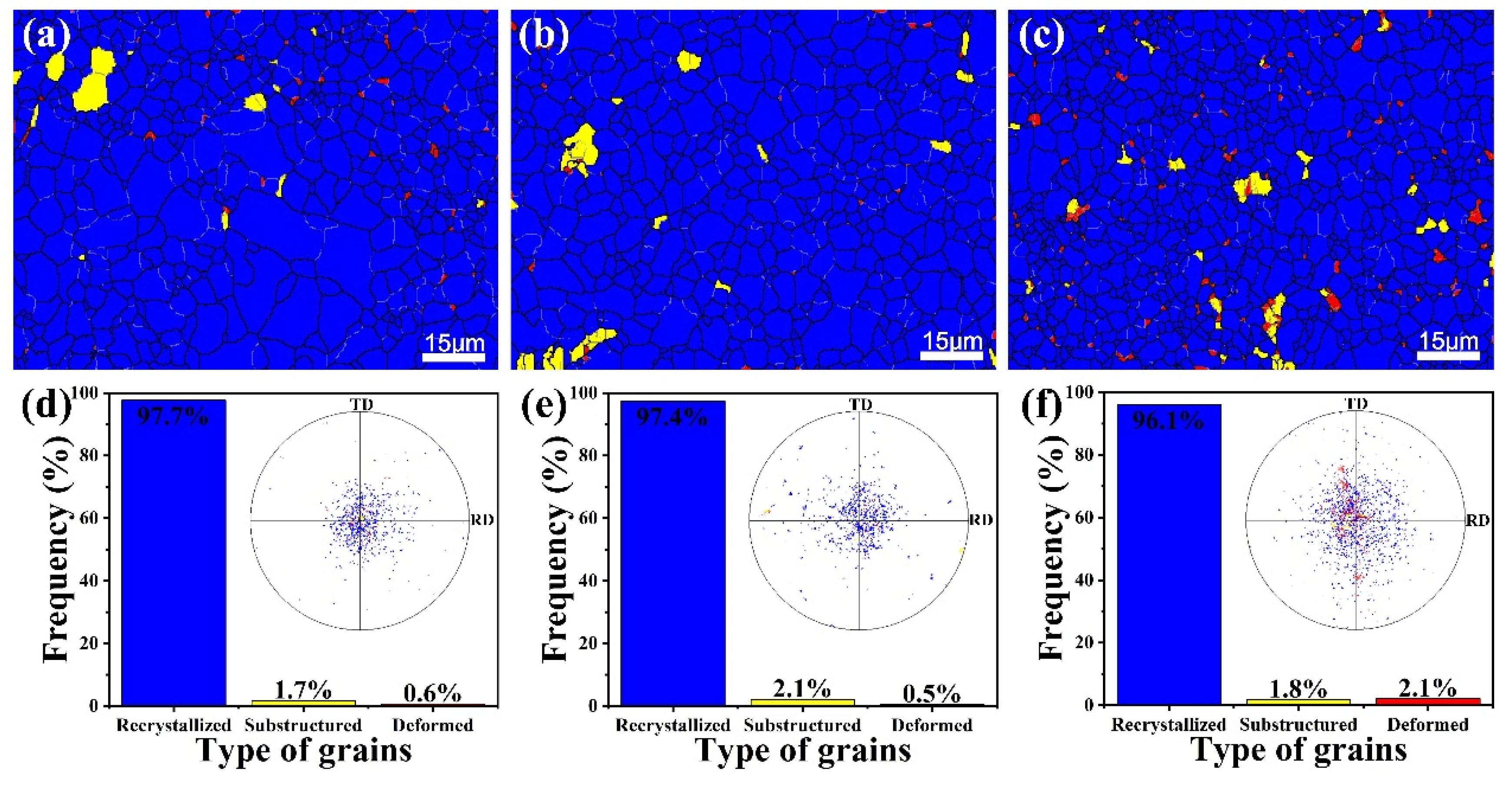
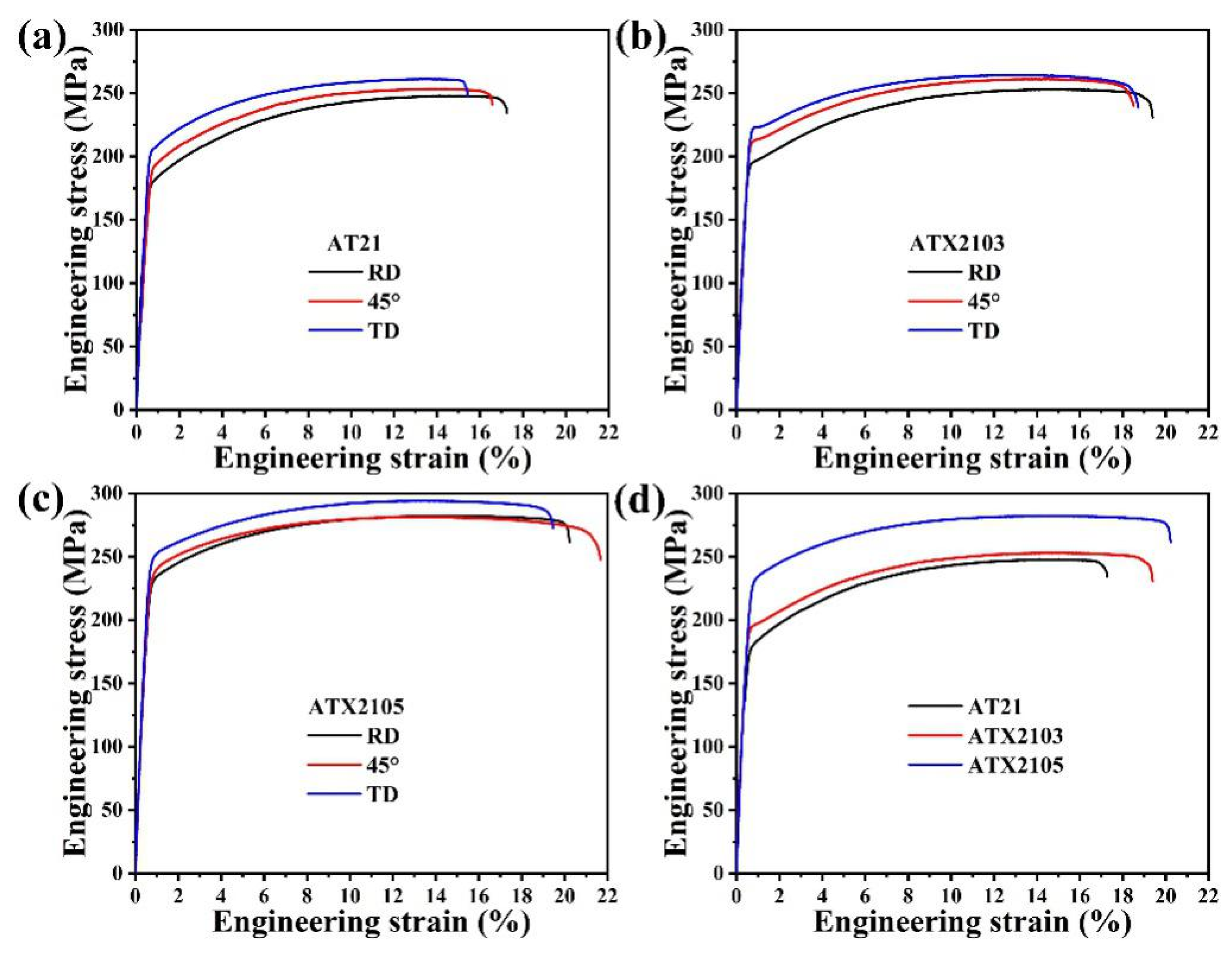
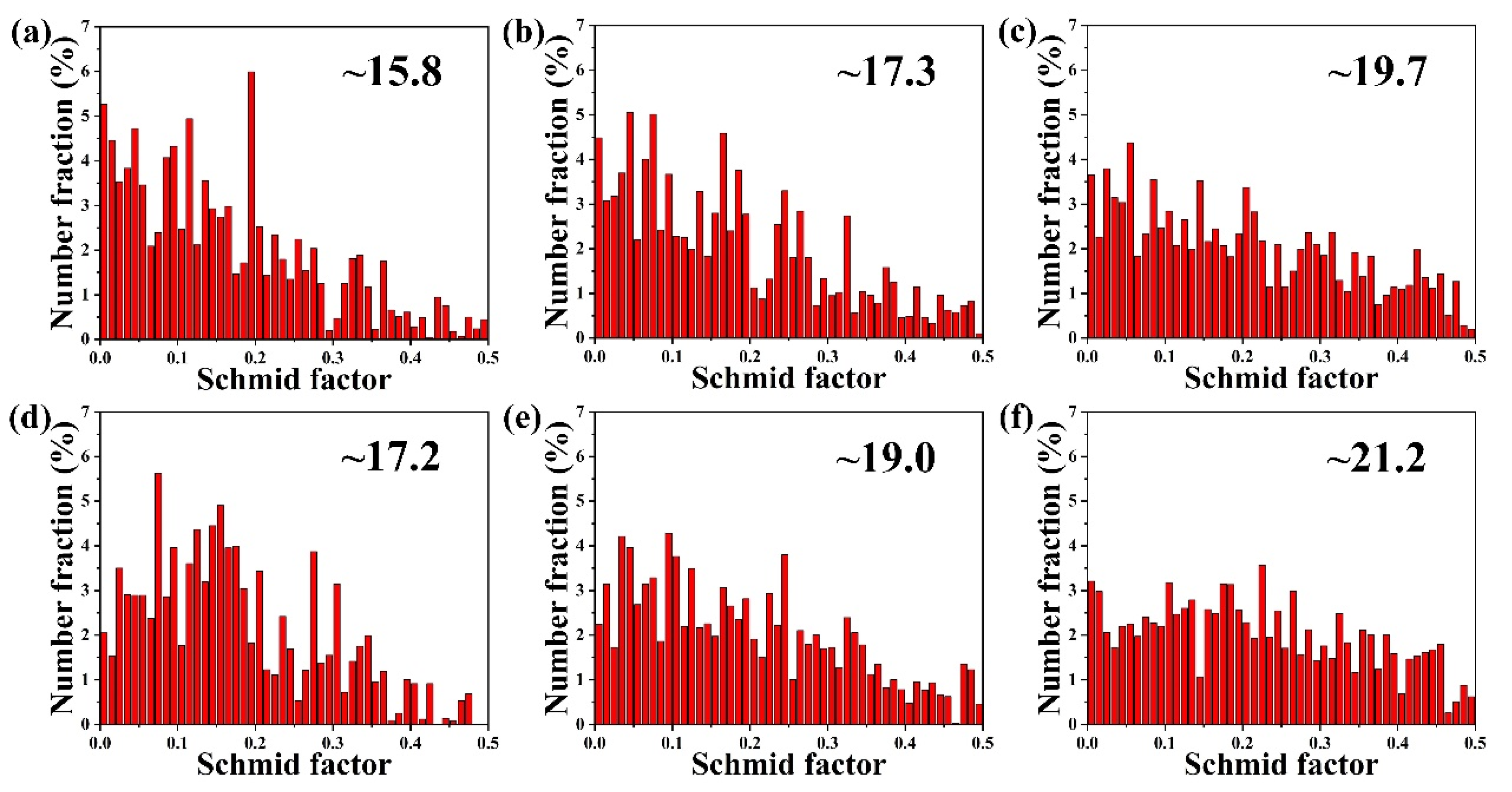

| Nominal Composition | Measured Composition (wt.%) | |||
|---|---|---|---|---|
| Al | Sn | Ca | Mg | |
| Mg-2.0Al-0.8Sn-0.0Ca | 1.96 | 0.77 | - | Bal. |
| Mg-2.0Al-0.8Sn-0.3Ca | 1.98 | 0.83 | 0.28 | Bal. |
| Mg-2.0Al-0.8Sn-0.5Ca | 2.01 | 0.79 | 0.51 | Bal. |
| YS (MPa) | UTS (MPa) | EL (%) | ||
|---|---|---|---|---|
| AT21 | RD | |||
| 45° | ||||
| TD | ||||
| ATX2103 | RD | |||
| 45° | ||||
| TD | ||||
| ATX2105 | RD | |||
| 45° | ||||
| TD | ||||
| Nominal Composition | Calculated YS/MPa | Measured YS/MPa | Deviation/MPa | ||||
|---|---|---|---|---|---|---|---|
| AT21 | 139.8 | 0 | 13.6 | 23.2 | 176.6 | 171.0 | −5.5 |
| ATX2103 | 146.8 | 10.7 | 13.6 | 24.8 | 195.6 | 192.4 | −3.2 |
| ATX2105 | 167.4 | 19.2 | 13.6 | 25.8 | 226.0 | 226.0 | 0 |
Publisher’s Note: MDPI stays neutral with regard to jurisdictional claims in published maps and institutional affiliations. |
© 2021 by the authors. Licensee MDPI, Basel, Switzerland. This article is an open access article distributed under the terms and conditions of the Creative Commons Attribution (CC BY) license (https://creativecommons.org/licenses/by/4.0/).
Share and Cite
Miao, Y.; Wang, C.; Wang, M.; Deng, H.; Ma, P.; Li, Z. Enhanced Mechanical Properties and Isotropy of Mg-2Al-0.8Sn Alloy through Ca Addition. Materials 2021, 14, 7557. https://doi.org/10.3390/ma14247557
Miao Y, Wang C, Wang M, Deng H, Ma P, Li Z. Enhanced Mechanical Properties and Isotropy of Mg-2Al-0.8Sn Alloy through Ca Addition. Materials. 2021; 14(24):7557. https://doi.org/10.3390/ma14247557
Chicago/Turabian StyleMiao, Yuan, Chao Wang, Minghui Wang, Hai Deng, Pinkui Ma, and Zhigang Li. 2021. "Enhanced Mechanical Properties and Isotropy of Mg-2Al-0.8Sn Alloy through Ca Addition" Materials 14, no. 24: 7557. https://doi.org/10.3390/ma14247557
APA StyleMiao, Y., Wang, C., Wang, M., Deng, H., Ma, P., & Li, Z. (2021). Enhanced Mechanical Properties and Isotropy of Mg-2Al-0.8Sn Alloy through Ca Addition. Materials, 14(24), 7557. https://doi.org/10.3390/ma14247557






